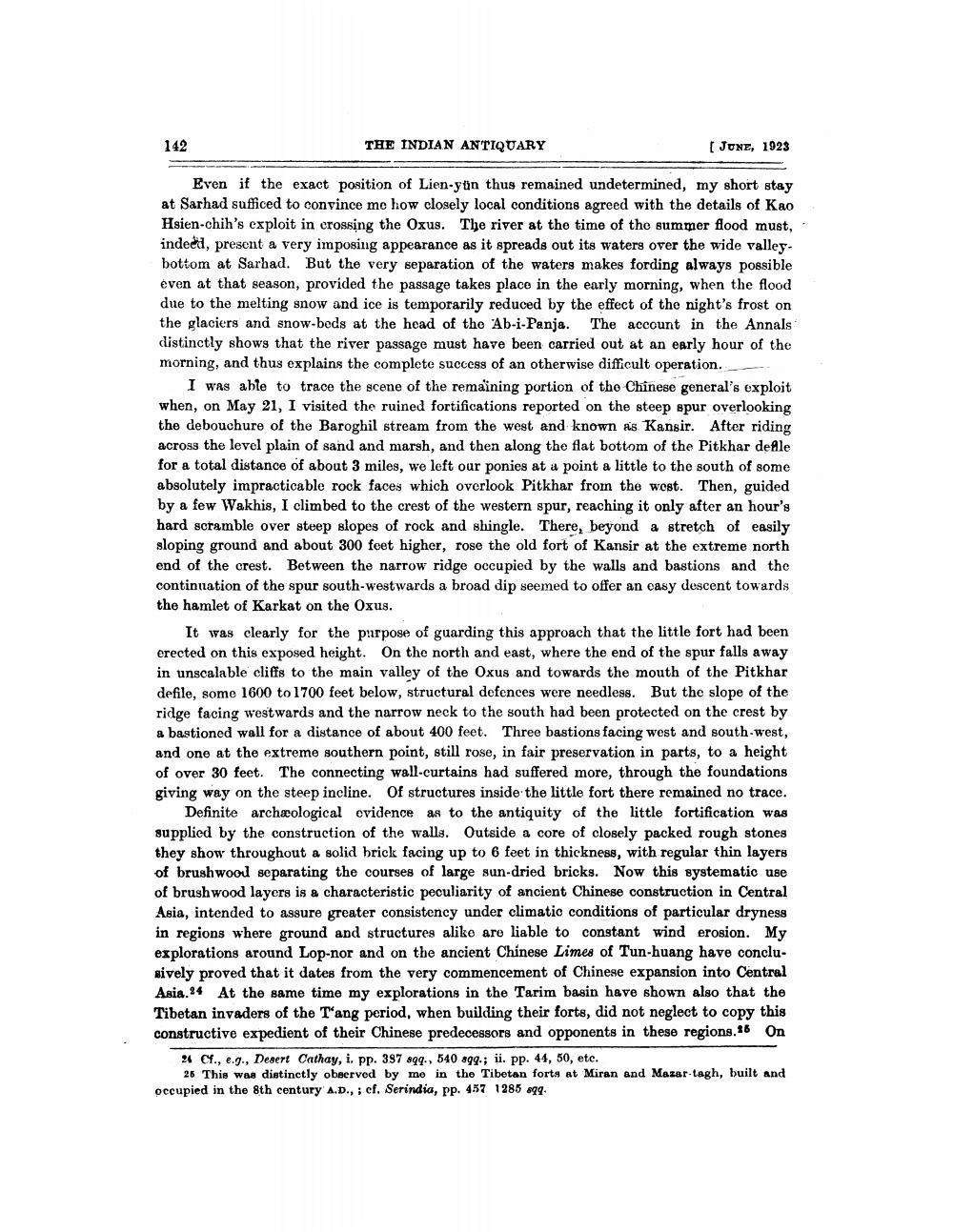________________
142
THE INDIAN ANTIQUARY
(JUNE, 1923
Even if the exact position of Lien-yön thus remained undetermined, my short stay at Sarhad sufficed to convince me how closely local conditions agreed with the details of Kao Hsien-chih's exploit in crossing the Oxug. The river at the time of the summer flood must, indeed, present a very imposing appearance as it spreads out its waters over the wide valley. bottom at Sarhad. But the very separation of the waters makes fording always possible éven at that season, provided the passage takes place in the early morning, when the flood due to the melting snow and ice is temporarily reduced by the effect of the night's frost on the glaciers and snow-beds at the head of the Ab-i-Panja. The account in the Annals distinctly shows that the river passage must have been carried out at an early hour of the morning, and thus explains the complete success of an otherwise difficult operation._
I was able to trace the scene of the remaining portion of the Chinese general's exploit when, on May 21, I visited the ruined fortifications reported on the steep spur overlooking the debouchure of the Baroghil stream from the west and known as Kansir. After riding across the level plain of sand and marsh, and then along the flat bottom of the Pitkhar de Ale for a total distance of about 3 miles, we left our ponies at a point a little to the south of some absolutely impracticable rock faces which overlook Pitkhar from the west. Then, guided by a few Wakhis, I climbed to the crest of the western spur, reaching it only after an hour's hard scramble over steep slopes of rock and shingle. There, beyond a stretch of easily sloping ground and about 300 feet higher, rose the old fort of Kansir at the extreme north end of the crest. Between the narrow ridge occupied by the walls and bastions and the continuation of the spur south-westwards a broad dip seemed to offer an easy descent towards the hamlet of Karkat on the Oxus.
It was clearly for the purpose of guarding this approach that the little fort had been erected on this exposed height. On the north and east, where the end of the spur falls away in unscalable cliffs to the main valley of the Oxus and towards the mouth of the Pitkhar defile, some 1600 to 1700 feet below, structural defences were needless. But the slope of the ridge facing westwards and the narrow neck to the south had been protected on the crest by a bastioned wall for a distance of about 400 feet. Three bastions facing west and south-west, and one at the extreme southern point, still rose, in fair preservation in parts, to a height of over 30 feet. The connecting wall-curtains had suffered more, through the foundations giving way on the steep incline. Of structures inside the little fort there remained no trace.
Definite archæological evidence as to the antiquity of the little fortification was supplied by the construction of the walls. Outside a core of closely packed rough stones they show throughout a solid brick facing up to 6 feet in thickness, with regular thin layers of brushwood separating the courses of large sun-dried bricks. Now this systematic use of brushwood layers is a characteristic peculiarity of ancient Chinese construction in Central Asia, intended to assure greater consistency under climatic conditions of particular dryness in regions where ground and structures alike are liable to constant wind erosion. My explorations around Lop-nor and on the ancient Chinese Limes of Tun-huang have conclusively proved that it dates from the very commencement of Chinese expansion into Central Asia. 24 At the same time my explorations in the Tarim basin have shown also that the Tibetan invaders of the Tang period, when building their forts, did not neglect to copy this constructive expedient of their Chinese predecessors and opponents in these regions.26 On
24 €4., e.g., Desert Cathay, i. pp. 397 899., 540 899.; ii. pp. 44, 50, etc.
26 This was distinctly observed by me in the Tibetan forts at Miran and Mazar-tagh, built and occupied in the 8th century A.D., ; cf. Serindia, pp. 457 1285 899.




